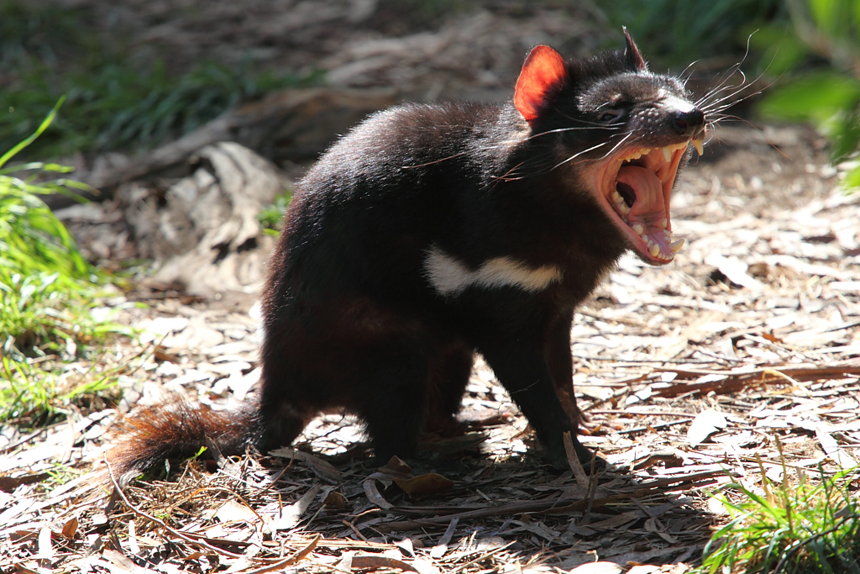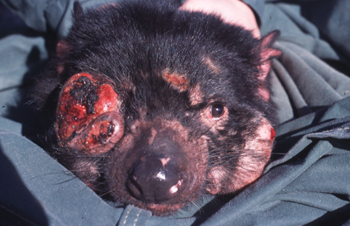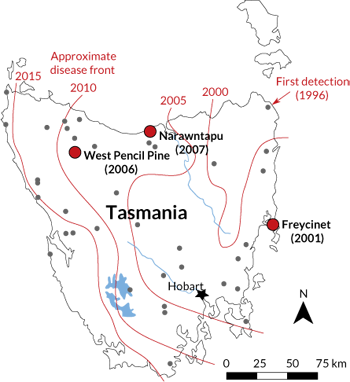Tasmanian devils begin to resist infectious cancer
Genetic tweaks are helping the Australian species ward off the killer disease

A contagious facial tumor has killed up to 95 percent of Tasmanian devils in some locations. But genetic variants in a small number of devils may let them avoid the disease. This discovery could be good news for the species.
Chen Wu/Wikimedia Commons (CC-BY 2.0)
A contagious cancer has been killing off Tasmanian devils in large numbers. But some have avoided the disease. The key to their salvation, a new study shows, has been their genes.
Tasmanian devils are small, aggressive marsupials on the Australian island of Tasmania. In 1996, researchers noticed some devils had tumors on their faces. Those cancers can stop an animal from eating and breathing, causing death. Unlike most human cancers, this one can spread from animal to animal. The infectious disease was first traced to a female devil. It spread its cancer to other devils through biting. (These animals frequently bite each other during mating.) The disease has now wiped out about 80 percent of the fierce animals. In some places, it has killed up to 95 percent of them.
Usually cells from different animals can’t grow in each other’s’ bodies. If you kiss your mom, her cells don’t start growing on your lips. The immune system, which helps fight off germs, also kills cells from other individuals. That is why people who get organ transplants have to take drugs to stop their bodies from rejecting those “foreign” organs. But devil facial tumors can hide from the immune system.

This was one reason scientists worried about the devils. “What we reluctantly felt was that this was the end for the Tasmanian devil,” says Jim Kaufman. There were worries it could go extinct “because they really didn’t have a defense.” Kaufman is a scientist who studies how the immune system evolved. He works at the University of Cambridge in England.
But researchers have just turned up good news. Many devils have versions of genes that may protect them from the cancer. Researchers reported this August 30 in Nature Communications. Concludes Kaufman, this “is really the most hopeful thing I’ve heard in a long time.”
In the genes
Menna Jones is a conservation biologist at the University of Tasmania in Hobart. As the cancer spread across Tasmania, she and her coworkers collected DNA from devils in three places. They did this both before and after the disease arrived at the locations.
Jones then teamed up with Andrew Storfer. He is an evolutionary geneticist from Washington State University in Pullman. His team examined the devil’s genetic instruction book, or genome. These researchers wanted to see if there was something special about devils who remained healthy after the infectious disease arrived. That might explain why they survived while the rest did not.
Some scientists had suspected the survivors just hadn’t caught the cancer yet, Kaufman notes. It was thought they had been too young to breed and get bitten. The new study, though, indicates that differences in their DNA may have protected some devils from the cancer.
Storfer and his team found more than 90,000 DNA spots where a small number of devils have a different base — an information-carrying component of DNA — than in most devils. These genetic spelling differences are known as single nucleotide polymorphisms (PAH-lee-MORF-isms), or SNPs, pronounced “snips.” The team looked for SNPs that had been rare before the tumor swept through a population but then became common after the disease arrived. Such a pattern could indicate that natural selection was working. This evolutionary process meant devils with the right SNP variants would avoid the deadly infection.
Two parts of the genome in all three of the devil populations contained SNPs that fit such a profile. Because the two regions changed in all three populations, the change probably didn’t happen by chance, the researchers say. These variants aren’t new. They were already there. But very few devils had them before the tumor came. What changed? Only devils with those SNPs survived long enough to breed and have babies. And their offspring all inherited the protective SNPs.
Those two genome regions contain a total of seven genes. Genes are the specific instructions in the big genome instruction book. They tell cells how to build particular proteins. Proteins do most of the work of building cells, digesting food and all the other things a body must do. Some genes that fight the facial tumor have, in other mammals, been shown to combat cancer or control the immune system. The researchers, however, aren’t sure which of the genes were most protective for the devils, let alone how they might work.

One day, scientists might use the new SNP data to better predict which devils will be at risk of the deadly face cancer. Breeding programs set up to save the devils might also use these data. Such programs might mate animals that carry the survival variants to ones that don’t. That would up the chance that the next generation would carry the guardian SNPs.
But there is a new complication. Last year, a second devil facial cancer emerged. Also infectious, it looks very much like the first tumor. In this case, it started in a male. Katherine Belov is a comparative genomicist at the University of Sydney in Australia. Researchers don’t know whether the SNPs that allow devils to resist the first infectious cancer will also work against the second, he notes. That’s why conservation biologists should not breed the resistance genes into all Tasmanian devils, she warns.
Limiting which devils breed with which others could reduce the diversity of genes in this species. Genetic diversity is high when there are many versions of genes present throughout members of a species. And devils need all the diversity they can get to cope with other diseases and other unknown challenges in the future, Belov says. Restricting breeding to animals that have these anti-tumor SNPs could limit the species’ ability to overcome other problems in the future.
Cancers that spread
Several cancer can be spread by infectious microbes, such as viruses. Feline leukemia is a well-known example. But what afflicts the devils is different. It’s not a germ that infects them but a sickening cell — a cancer cell — from a member of their own species.
Scientists used to think that such contagious cancer cells were rare. For a long time, only one type was known — in dogs. For 11,000 years, some of them had been spreading such an infectious dog cancer through mating. Then the first contagious devil cancer emerged 20 years ago. Scientists reported the second one last year.
But it was far from the only such new infectious cancer. Also in 2015, researchers found such a cancer — in this case, a leukemia — infecting soft shell clams. This past June, researchers reported finding more contagious shellfish cancers. They infected mussels, cockles and golden shell clams. Golden shell clams (Polititapes aureus) caught their cancer from pullet carpet shell clams (Venerupis corrugate), which no longer carry the disease. That was the first report of such contagious cancer cells infecting a new species.
With two such infectious cancers in Tasmanian devils, some researchers now wonder if their species is especially prone to contagious cancers. No one can yet answer that.
But in more good news for the devils, scientists have reared many healthy animals in captivity. Last month, 33 of them were released into the wild. Those devils had been given vaccines to help them ward off the facial tumor. Scientists hope they will breed with wild devils remaining to increase their genetic diversity.
The researchers have outfitted the newly released devils with collars with tracking “tags.” This will help them map the animals as they move around. The collars also are reflective. That may help to save these animals from the fate of devils previously released: Many were hit and killed by cars.







